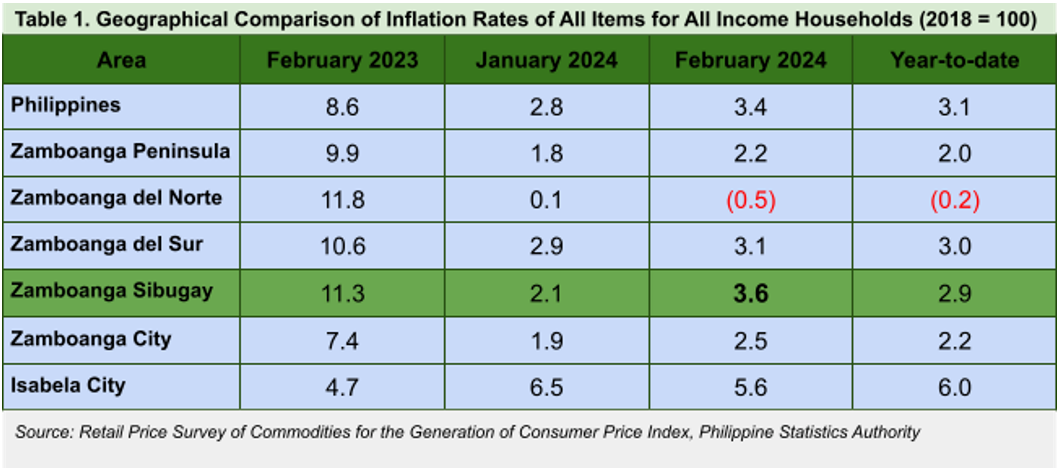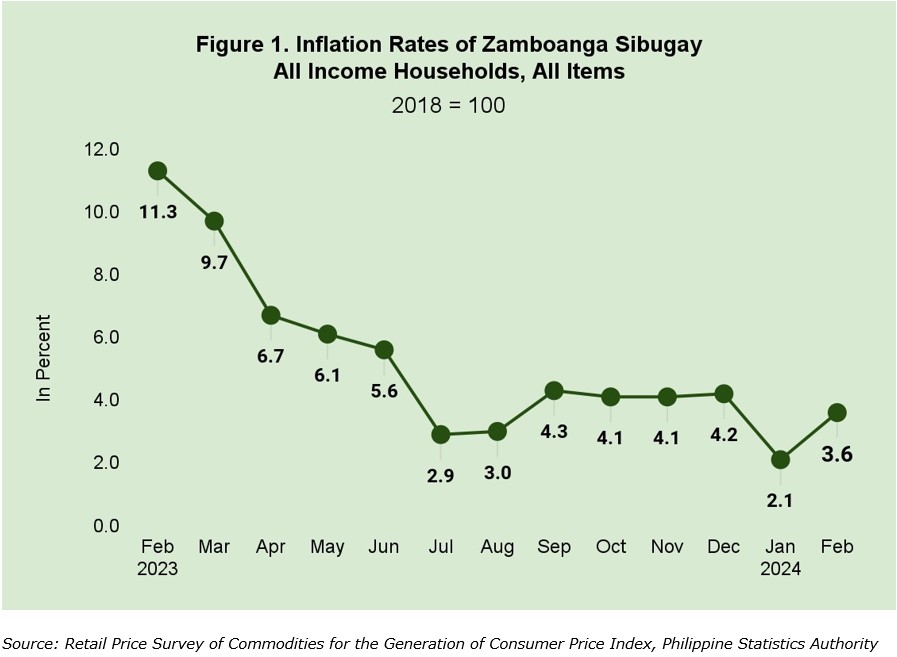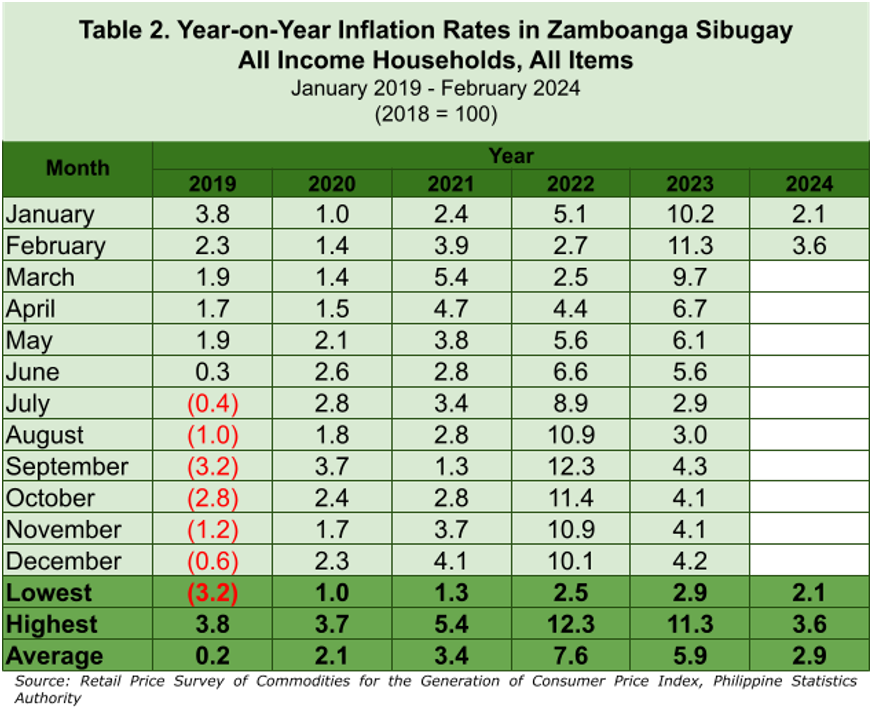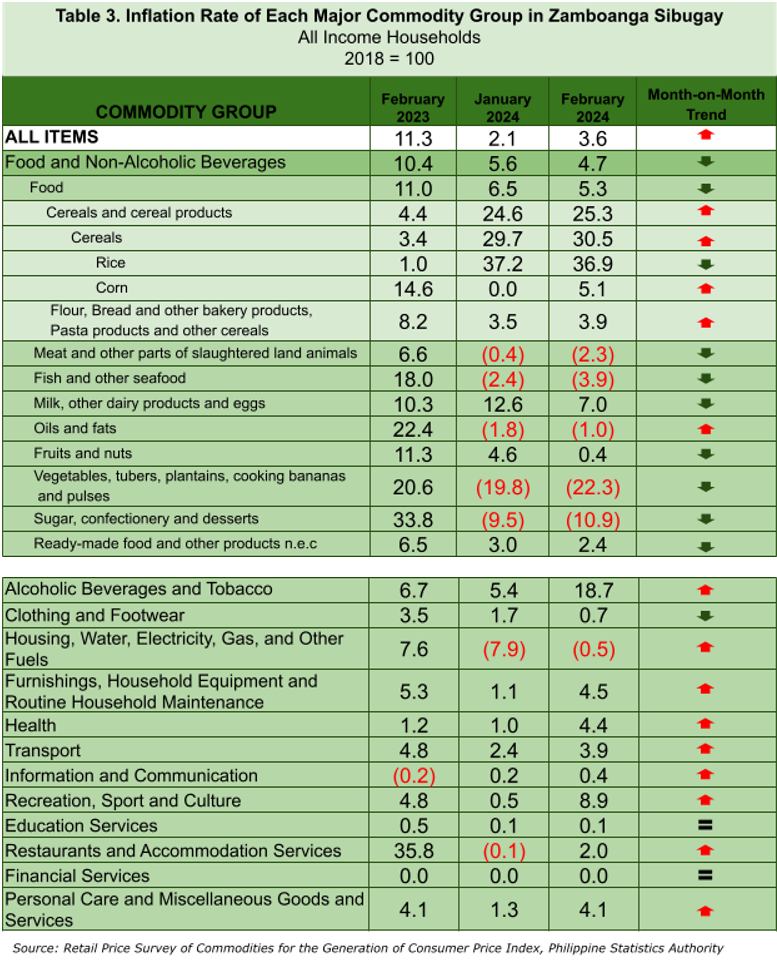Zamboanga Sibugay’s overall inflation clambered up to 3.6 percent in February 2024 from 2.1 percent in January 2024. This is higher than the regional and national inflations at 2.2 percent and 3.4 percent, respectively. Nevertheless, it is way lower than February 2023’s 11.3 percent.

Among five areas in Zamboanga Peninsula, the province ranked second with the highest inflation. Isabela City had the biggest inflation at 5.6 percent, Zamboanga del Sur came third with 3.1 percent followed by Zamboanga City with 2.5 percent while Zamboanga del Norte ranked last with -0.5 percent.

The following commodity groups were the top contributors as to the province’s increasing inflation, including:
Housing, water, electricity, gas and other fuels at -0.5 percent from -7.9 percent, sharing 47.3 percent of the uptrend;
Alcoholic beverages and tobacco at 18.7 percent from 5.4 percent, contributing 12.7 percent; and
Restaurants and accommodation services at 2.0 percent from -0.1 percent, contributing 12.6 percent of the trend.
Moreover, the following commodity groups also recorded an increase in their inflation rates namely:
Furnishings, household equipment and routine household maintenance at 4.5 percent from 1.1 percent;
Health at 4.4 percent from 1.0 percent;
Transport at 3.9 percent from 2.4 percent;
Information and communication at 0.4 percent from 0.2 percent;
Recreation, sport and culture at 8.9 percent from 0.5 percent; and
Personal care, and miscellaneous goods and services at 4.1 percent from 1.3 percent.

On the other hand, below are the commodity groups whose inflation indices exhibited downward trend:
Food and non-alcoholic beverages at 4.7 percent from 5.6 percent; and
Clothing and footwear at 0.7 percent from 1.7 percent.
Meanwhile, two commodity groups maintained their inflation rates including:
Education services at 0.1 percent; and
Financial services at 0.0 percent.

As for the food inflation in Zamboanga Sibugay, the following two sub-food groups indicated an increase of their inflation rates:
Cereals and cereal products at 25.3 percent from 24.6 percent; and
Oils and fats at -1.0 percent from -1.8 percent.
On the contrary, the following sub-food groups recorded a deceleration of their inflation rates namely:
Meat and other parts of slaughtered land animals at -2.3 percent from -0.4 percent;
Fish and other seafood at -3.9 percent from -2.4 percent;
Milk, other dairy products and eggs at 7.0 percent from 12.6 percent;
Fruits and nuts at 0.4 percent from 4.6 percent;
Vegetables, tubers, plantains, cooking bananas and pulses at -22.3 percent from -19.8 percent;
Sugar, confectionery and desserts at -10.9 percent from -9.5 percent; and
Ready-made food and other food products n.e.c. at 2.4 percent from 3.0 percent.
As to the staple food in the province, rice and corn exhibited an opposing trend in their inflation rates. The former showed a decrement of 0.3 percentage points, that is, from 37.2 percent in January 2024 to 36.9 percent in February 2024 while the latter revealed an increase from 0.0 percent to 5.1 percent.
Technical Notes
Uses of CPI
The CPI is most widely used in the calculation of the inflation rate and purchasing power of peso. It is a major statistical series used for economic analysis and as a monitoring indicator of government economic policy.
Computation of CPI
The computation of the CPI involves consideration of the following important points:
- Base Year/Period - A period, usually a year, at which the index number is set to 100. It is the reference point of the index number series.
- Market Basket - A sample of the thousands of varieties of goods purchased for consumption and services availed by the households in the country selected to represent the composite price behaviour of all goods and services purchased by consumers.
- Weighting System - The weighting pattern uses the expenditures on various consumer items purchased by households as a proportion to total expenditure.
- Formula - The formula used in computing the CPI is the weighted arithmetic mean of price relatives, the Laspeyre’s formula with a fixed base year period (2006) weights.
- Geographic Coverage - CPI values are computed at the national, regional, and provincial levels, and for selected cities.
Note: CPIs and inflation rates by province and selected city are posted at the PSA website
(https://openstat.psa.gov.ph/).
ATTY. RICHARD D. TABIGNE
Chief Statistical Specialist
Provincial Statistical Office - Zamboanga Sibugay
